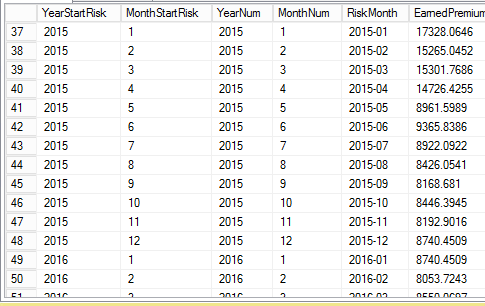The first part of the query grabs Policy's Premiums, Effective and Expiration dates. The second part creates Calendar, and third part (final SELECT statement) returns Earnings broken down by Month and Year.
Everything works fine and takes just 3 seconds to display the result. But then I need to filter what PolicyNumbers to work with, basically I need to get rid of PolicyNumber's that dont have @ClassCode. So for that in the first part of the query I placed WHERE clause:
WHERE State IN ('CA','NV','AZ')
AND PolicyNumber IN (
SELECT PolicyNumber
FROM tblClassCodesPlazaCommercial
GROUP BY PolicyNumber
HAVING COUNT (CASE WHEN ClassCode NOT IN (@ClassCode)
THEN 1 END)=0
)
The CASE statement will generate 1 for the ClassCode that is present in the list, else NULL will be generated. Now the count aggregate will count of 1 for each PolicyNumber. By setting = 0 we can make sure the PolicyNumber does not have any ClassCode present in the given list.
After that query spinning forever, becase @ClassCode can have more that 200 ClassCodes in SSRS report.
Interesting things is that both those statements works fine separately. But when I use them together (which is placed that WHERE clause in cte policy_data then execution takes forever.
Is any way to tell engine to do the first part of the query, and then calculate and break down Earnings for only those policies that have been filtered?
; WITH Earned_to_date AS (
SELECT Cast(EOMONTH (GETDATE(), -1) AS DATE) AS Earned_to_date
), policy_data AS (
SELECT
PolicyNumber
, Cast(PolicyEffectiveDate AS DATE) AS PolicyEffectiveDate
, Cast(PolicyExpirationDate AS DATE) AS PolicyExpirationDate
, WrittenPremium
, State
FROM PlazaInsuranceWPDataSet
WHERE State IN ('CA','NV','AZ')
/* -------This statement gives me trouble ----------------------*/
AND PolicyNumber IN (
SELECT PolicyNumber
FROM tblClassCodesPlazaCommercial
GROUP BY PolicyNumber
HAVING COUNT (CASE WHEN ClassCode NOT IN (5151)
THEN 1 END)=0
)
)
My entire code:
; WITH Earned_to_date AS (
SELECT Cast(EOMONTH (GETDATE(), -1) AS DATE) AS Earned_to_date
), policy_data AS (
SELECT
PolicyNumber
, Cast(PolicyEffectiveDate AS DATE) AS PolicyEffectiveDate
, Cast(PolicyExpirationDate AS DATE) AS PolicyExpirationDate
, WrittenPremium
, State
FROM PlazaInsuranceWPDataSet
WHERE State IN ('CA','NV','AZ')
/* -------This statement gives me trouble ----------------------*/
AND PolicyNumber IN (
SELECT PolicyNumber
FROM tblClassCodesPlazaCommercial
GROUP BY PolicyNumber
HAVING COUNT (CASE WHEN ClassCode NOT IN (@ClassCode)
THEN 1 END)=0
)
)
, digits AS (
SELECT digit
FROM (VALUES (0), (1), (2), (3), (4)
, (5), (6), (7), (8), (9)) AS z2 (digit)
), numbers AS (
SELECT 1000 * d4.digit + 100 * d3.digit + 10 * d2.digit + d1.digit AS number
FROM digits AS d1
CROSS JOIN digits AS d2
CROSS JOIN digits AS d3
CROSS JOIN digits AS d4
), calendar AS (
SELECT
DateAdd(month, number, '1753-01-01') AS month_of
, DateAdd(month, number, '1753-02-01') AS month_after
FROM numbers
), policy_dates AS (
SELECT
PolicyNumber
, CASE
WHEN month_of < PolicyEffectiveDate THEN PolicyEffectiveDate
ELSE month_of
END AS StartRiskMonth
, CASE
WHEN PolicyExpirationDate < month_after THEN PolicyExpirationDate
WHEN Earned_to_date.Earned_to_date < month_after THEN Earned_to_date
ELSE month_after
END AS EndRiskMonth
, DateDiff(day, PolicyEffectiveDate, PolicyExpirationDate) AS policy_days
, WrittenPremium
FROM policy_data
JOIN calendar
ON (policy_data.PolicyEffectiveDate < calendar.month_after
AND calendar.month_of < policy_data.PolicyExpirationDate)
CROSS JOIN Earned_to_date
WHERE month_of < Earned_to_date
)
SELECT
Year(StartRiskMonth) as YearStartRisk,
Month(StartRiskMonth) as MonthStartRisk,
c.YearNum,c.MonthNum,
convert(varchar(7), StartRiskMonth, 120) as RiskMonth,
sum(WrittenPremium * DateDiff(day, StartRiskMonth, EndRiskMonth) / policy_days) as EarnedPremium
FROM tblCalendar c
LEFT JOIN policy_dates l ON c.YearNum=Year(l.StartRiskMonth) AND c.MonthNum = Month(l.StartRiskMonth)
AND l.StartRiskMonth BETWEEN '01-01-2015' AND '12-31-2016'
WHERE c.YearNum Not IN (2017)
GROUP BY convert(varchar(7), StartRiskMonth, 120),
Year(StartRiskMonth) , Month(StartRiskMonth),
c.YearNum,c.MonthNum
ORDER BY c.YearNum,c.MonthNum
What would be the best way to improve the performance? I created non-clustered index on PolicyNumber on both tables. But still nothing.
Like I said, seems to me that if SQL Engine would process the first part(PolicyNumber filtering) that takes 3 seconds, and then do the second part (calculation for those PolicyNumber's) that takes another 3 seconds - that would be awesome.
Execution plan:
Final result:


